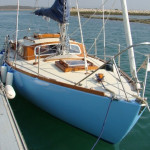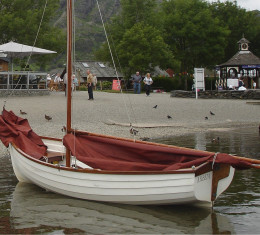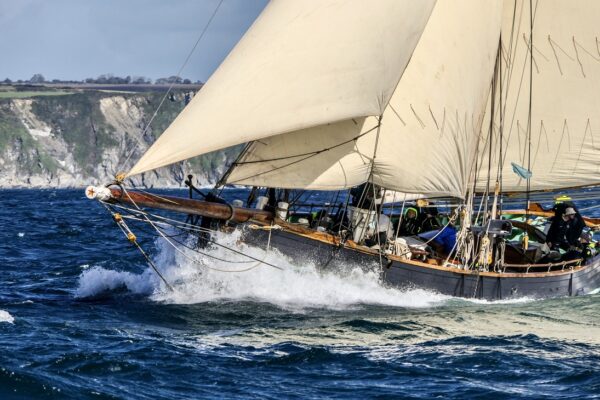Sailing yachts
Full specification
Wooden ships comments on this Top Hat Sloop
The JOG (Junior Offshore Group) was founded in 1950 to encourage off-shore racing in affordable small yachts in the hard post war days. Many famous names were involved including Capt John Illingworth and some interesting design evolved.
This was cutting edge stuff at a time when sailing a 21’wl yacht across the Channel was a major exploit for most people.
The Top Hat was designed by John Illingworth and his business partner Angus Primrose as a development of the JOG rules but retained the 21’wl.
She was regarded as a cruiser racer with surprising accommodation for her size and built to the latest high tech standards by Souters of Cowes, incorporating maximum strength without unnecessary weight.
The versatility and amazing performance rapidly made the design very popular.
It is difficult to describe this particular yacht without constant exaggeration. Very simply, the yacht is immaculate, the construction features are an education and the details of the finish have to be seen in situ to be appreciated.
While she was built by Souters in 1965, the owner took 10 years to fit out the internal joinery and subsequently kept the yacht ashore, only using her for a few weeks each year and she was laid up in 2003 until purchase by the present owner in 2008.
A detailed 2008 survey report is available.
The yacht was refitted for the present owner by Tim Gilmore at Dolphin Yard, Emsworth.
A large file detailing all work done from build to present time and many detailed drawings comes with the yacht.
Souters made a particular study of monocoque wooden hull construction and perfected the technique which gives max strength for minimum weight.
The construction uses a hull skin built of 4 laminations of 3mm mahogany laid up in crossing diagonals with resorcinol glue.
The hull was repainted by Dolphin Yard, Emnsworth and is perfect.
Steam bent Canadian Rock Elm timbers ¾” x 5/8” at approx 10” c are secured with conventional copper rivets and roves
The back-bone is built in laminated mahogany.
The floors are laminated mahogany tapered like leaf springs to release the loads gradually as they rise well up the sides of the hull.
The 1 ¼ ton lead keel is secured with bronze bolts through the floors. Bolts drawn in 2008, found sound and replaced.
Spruce is used for the longditudinals, a timber with excellent strength for weight.
The deck is 3/8” marine ply, painted.
Excellent deck fittings exactly where you want them with a mushroom vent on the small aft deck to ventilate the aft locker, a pair of mooring line cleats on the aft deck with associated bronze fairleads over the deck edge, stbd midships cleat to take springs and breast lines, a proper varnished oak Sampson post on the fore deck to take forward lines and anchor chain which comes up frm below through a chromed bronze nacelle.
Tufnol cleats either side on the fore deck and a single stainless steel chain roller over the stem.
Deck beams are laminated mahogany again giving strength for min weight and an attractive appearance.
Varnished mahogany toe rail carries headsail sheet track.
Stainless steel pulpit, push-pit and stanchions with twin guard wires on quick release McNaughton clips.
The mahogany coach-roof coamings and cock-pit coamings are also laminated in several layers and finished with a constant colour and perfect varnish.
The sheet winches are mounted on swelling formed in the outer face of the coamings allowing a small pocket under accessed from the inside face of the coaming – a typical example of clever design and even more clever building.
New Perspex windows in the coach-roof make the cabin very light and spacious.
Grab rails on the coach-roof.
Forward hinging, opening entrance hatch with hinged perspex side flaps which support the lid in half-open position. Three washboards to the entrance.
The cock-pit coamings rise to the same level as the coach-roof deck giving wonderful protection in the cock-pit and back support.
The seats are built over the long quarter berths back as far as the main sheet track with a small, top-opening locker each side in the aft corner. The seats have scrubbed teak slats to take wear and provide grip.
Similar teak slats in the self draining cock-pit well sole, draining through the transom.
Mahogany rudder on bronze rudder stock which emerges through the cock-pit sole with a fine laminated tiller and Simpson Lawrence chromed bronze hinged tiller-head.
Varnished mahogany fore hatch with thick Perspex light between grab handles.
Bermudian sloop rig on Proctor aluminium mast stepped in a transverse stainless steel shoe on the deck in front of the coach-roof.
Double spreaders.
Stainless steel rigging reported in the 2008 survey to be well within it’s serviceable life.
Norseman terminals to stainless steel rigging screws on stainless steel in board chain plates.
Single fore stay to a deck fitting just aft of the stemhead.
Inner fore stay from just forward of the fore hatch to the spreaders gives the lower mast extra support.
Twin standing back-stays to internal s/s chain plates at the quarters.
Cap shrouds to internal deck-edge chain plates.
Hangers from upper spreader roots to lower spreaders.
The lower shroud has been cleverly moved from it’s original place at the deck edge chain plate to a new position eye through the deck by the fwd corners of the coach-roof which allows easier passage along the deck past the shrouds. Simples.
New 2008 rope halyards.
New 2008 alloy boom with in-boom reefing pennants on clutches, sheeted to a curved main sheet track across the after end of the cock-pit over the rudder stock where it does not impeded the helmsman.
Main sheet with tunol blocks and jammer on the lower block. Moveable cars limit the travel of the main sheet on the track.
Kicker on tackle
Pair of bottom action Lewmar sheet winches on the cock-pit coamings with associated tufnol cleats.
Pair of top action mast halyard winches. Pair of winch handles clip securely into the mast step, instantly accessible.
New 2009 Rotostay stainless steel headsail reefing gear.
Sails.
New 2009 mainsail, genoa on furling gear, working jib.
Older storm jib and Spinnaker, bother very serviceable.
Mainsail cover.
Petter single cylinder 3.5hp air-cooled diesel engine, centre-line installation to centre-line 3-blade prop.
The engine is mounted under the forward end of the cock-pit well and covered in the cabin by the vertical steps to the entrance.
Access is by removal of the steps or by an opening either side in the quarter berth tunnels.
Electric start.
1 x 12v battery charged by 12v dynamo belt driven off the engine
Stainless steel fuel tank above the engine under the cock-pit sole.
Twin engine controls in the cock-pit well. The gear engage lever is recessed into the side of the well.
Unique helicopter fitting serves as a throttle control, also in a recess in the well side.
This is a very simple little engine which started easily and ran smoothly, surprisingly quiet and gives about 4knts, just enough to get you out into the channel and away because she sails like a dinghy in a breath of wind.
Electrical switch-board on the bulkhead inside the cabin with perfectly aligned cables feeding into it.
4 berths.
Port and stbd quarter berths run under the cock-pit seats and well out into the cabin to form the saloon cabin settees.
3-step removeable vertical mahogany ladder to the cabin entrance.
The galley and chart desk are set midships, galley to stbd, chart desk to port. The chart desk will take a folded Admiralty chart.
A shooting stick will be found clipped under the chart desk which locates in a socket in the sole either side to provide a perch for either galley or chart desk use.
The galley as a 2-burner gimballed suspended gas cooker and alongside it a sink with inset lid with vertical action hand-pump water in and waste out.
Shelf above under the deck takes galley stuff.
Water is carried in 3 stainless steel tanks in the bilge, shaped to the bilge V with interfeed pipes and bronze manifold allowing selection of each tank individually.
The chart desk to port will take a full size Admiralty chart. Nav instruments above. The chart work instruments lie in blue felt lined hollows shaped to the instruments.
A knee-rest bar below the desk and the galley gives extra stability.
The cabin sole boards are exquisitely made in lifting slatted sections.
The cabin steps are studded with wooden non-slip studs. Also stud patches below galley and chart desk.
Oval aperture in the forward bulkhead provides hull stiffness in way of the mast and takes the mast compression loads.
V-berths with the under berth panels sloped away frm the centre-line to make more floor space when the yacht is heeled.
Sea toilet between the berths with a varnished mahogany lid which also acts as a step up to exit the fore hatch above.
Perfectly varnished exposed ship’s side and laminated deck beams.
12v electric lights all round. Even the original chrome swivelling over-bunk lights have been modified to take the modern low current consumption LED bulbs.
Twin Danforth Corsair compasses, one either side of the entrance hatch.
Brookes and Gatehouse Hengist, Horsa, Homer, Harrier and Hector all in working order.
Garmin 152 GPS
Battery monitor
25lb CQR anchor with length of chain and warp.
Summer cover over cock-pit and coach-roof.
Avon Redstart dinghy with pump and oars.
It is rare to find such an exquisitely presented yacht of this age and whatever one pays for it will never be enough.
This Top Hat is an absolute pleasure to own and to sail.
The cabin gives very adequate comfort for two for an extended period of cruising, the cock-pit is very safe even in a sea and the construction will ensure she will take far more than her crew ever will.
This is fun on the water, as good as it gets.
Navigation gear.
Steering compass each side of the entrance hatch.
B&G Hengist, Horsa, Homer and Harrier
2009 Garmin GPS 152
LED nav lights and steaming light.
Hand bearing compass
2010 auto-pilot
Clock and barometer
Safety gear.
Folding radar reflector
First Aid kit
Fire blanket
2 torches in holders.
Flares
2 fire extinguishers
2 manual bilge pumps.
2 jack-stays
Deck gear.
8 fenders
4 warps
Ensign, staff and burgee
Boathook and deck brush
Avon Redstart dinghy with pump, oars and o/b bracket
Ground tackle
25lb CQR anchor
15lb CQR anchor
Warp and chain
Sundries.
12v hoover. Portable table. Cutlery and crockery. Galley bum straps.8 interior LED cabin lights. Engine spares.
Wooden Ships classic yachts brokers have an extensive database of boats for sale. With a wide range of sailboats, classic yachts, motor yachts and small classic boats, Wooden Ships has one of the largest selections of traditional wooden boats and yachts for sale in the UK.
Disclaimer:
These particulars have been prepared in good faith from information provided by the Vendors and are intended as a guide, Wooden Ships cannot guarantee or warrant the accuracy of this information nor warrant the condition of the vessel. The Purchaser should instruct his agent or surveyor to validate all details as necessary and satisfy himself with the condition of the vessel and its equipment.































